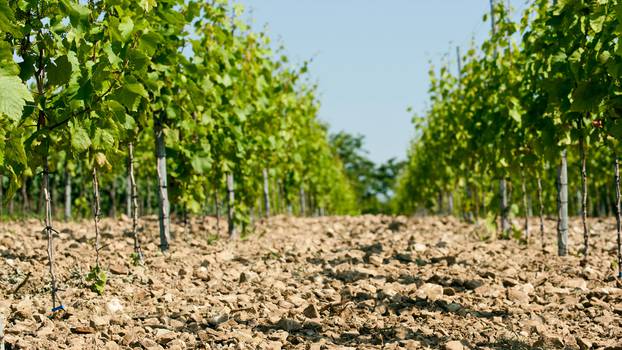Michaelsberg
Commonly known as the „Guardian of Zaberga?u“, the Cleebronner Michaelsberg rises as a cone- shaped mountain over the plains. With its ancient church at the peak, it is a widely visible landmark. According to a legend, the Saint Boniface fought the devil at the Michaelsberg mountain top. When the archangel Michael came to his rescue, he lost a feather. To honour Saint Michael and to house his feather, the little chapel was built right next to our vineyard.
The vines benefit from cold nights in the summertime as well as a constant air flow in this steep southern and south-eastern slope. The back of the mountain together with the adjacent Stromberg hills protect the plot from the cold northern and eastern drafts.
Variety: Lemberger
Soil: coloured marl (Bunter Mergel), stony / limy clay
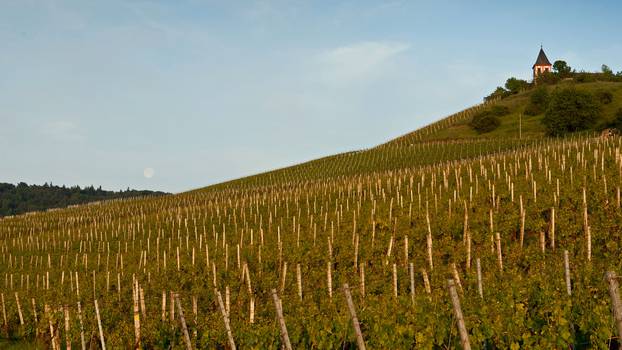
Coloured marl (Bunte Mergel)
More than 200 Million year ago coloured marl was deposited on top of the layers of gypsum keuper (Gipskeuper),. It is equally limy as the Gipskeuper, but not as heavy and compact. Both, Gipskeuper, the Bunte Mergel belong to the little developed, limy soils rich in magnesium Interestingly, Bunte Mergel soil delaminates and together with the decaying leaves, it blends with the mineral components.


Steingrüben
The pure Schilfsandstein (“reed sandstone”) soil of the Bo?nnigheimer Sonnenberg vineyard plot where the „Gru?benstein“ thrives, produces wines with a rich body, power and long finish. Nevertheless, the aroma remains tangy, fresh and tremendously vigorous. Due to the low lime concentration in the soil, the wines taste superbly elegant and delicate despite the hot climate at this site. The vines in this vinyeard grow on a 50 degree slope and were planted in the late 1960s. Variety: Riesling
Soil: Schilfsandstein (“reed sandstone”)
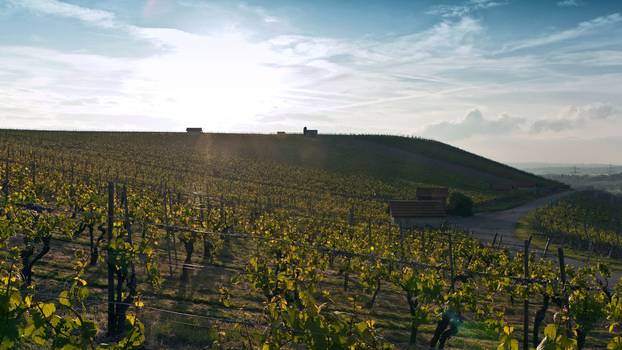
Schilfsandstein ("reed sandstone", the name dervies from abundant horsetail fossils)
The Schilfsandstein is characterised by its fine granulation and its high minerality. It was formed about 225 million years ago, when sandy river banks were slowly transformed into massive sandstone formations. The name originates from fossil plants found within the stones that were wrongly assumed to be reed stems.

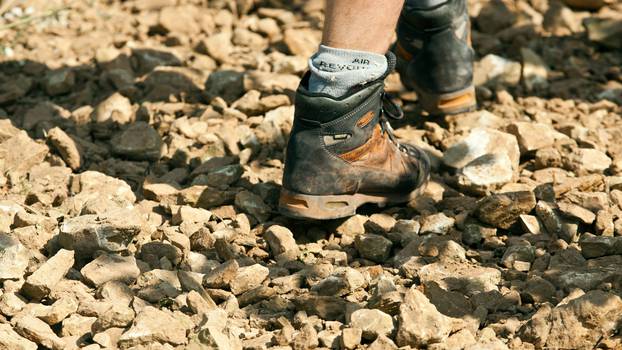
Kalkschupen
The “Kalkschupen“ vineyard is part of the Bo?nnigheimer Sonnenberg. It is a slope directly facing south with Gipskeuper soil. In the 1970’s the Pinot Noir vines were planted here in the most limy soils of our estate. The wines from this slope always taste more powerful than those grown in Schildsandstein. They display extraordinary elegance and a delicately structured acidity Variety: Pinot Noir
Soils: Gipskeuper, weathered limestone
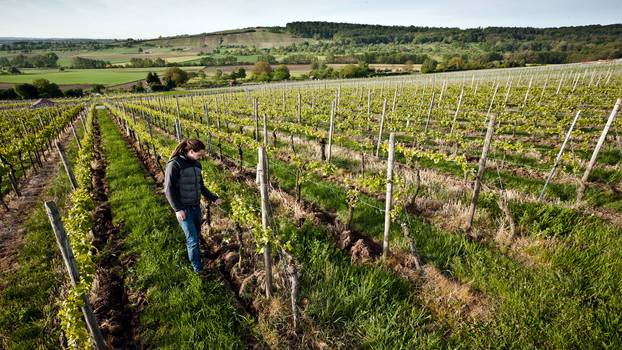
Gipskeuper
The Gipskeuper with its limy soil constitutes the first rise in the so-called Keuperlandschaft (keuper landscape). The soils are rich with clay and heavy. Carbonate dissolved from the lime dominates the soil water and slows down weathering. As a result, the 200-million-year-old soils are rather poorly developed. Throughout the centuries, wine-growers have deeply loosened up and ploughed the heavy keuper formations and thus transformed them into man-made Rigosol soil.

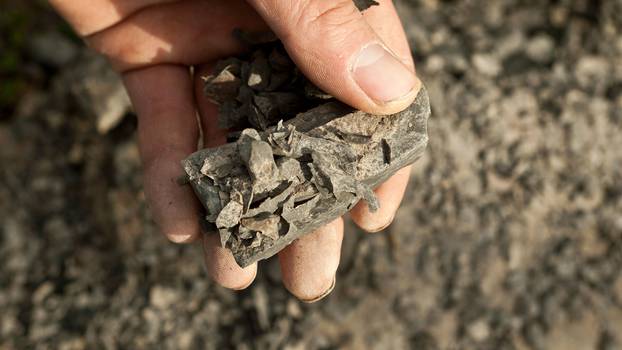
Bönnigheimer Sonnenberg
The Sonnenberg (literally translated: sunny hill), situated at the foothills of the Stromberg mountain in Bo?nnigheim, truly lives up to its name. An incline of up to 49 degrees guarantees an optimal exposure to the sun leading to intensely flavoured grapes. The heavy keuper soil is rich with nutrients. The vines grow on Schilfsandstein and Gipskeuper soils which are prefectly suited to produce extremely intensive wines with a complex character. Some of our best aged wines originate from this site, which was first mentioned in a document 1200 year ago.
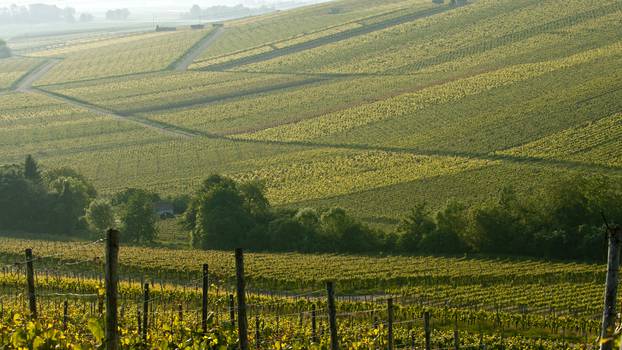
Schilfsandstein ("reed stone", the name derives from abandundant horsetail fossils)
The Schilfsandstein is characterised by its fine granulation and its high minerality. It was formed about 225 million years ago, when sandy river banks were slowly transformed into massive sandstone formations. The name originates from fossil plants found within the stones that were wrongly assumed to be reed stems.
Gipskeuper
The Gipskeuper with its limy soil constitutes the first rise in the so-called Keuperlandschaft (keuper landscape). The soils are rich with clay and heavy. Carbonate dissolved from the lime dominates the soil water and slows down weathering. As a result, the 200-million-year-old soils are rather poorly developed. Throughout the centuries, wine-growers have deeply loosened up and ploughed the heavy keuper formations and thus transformed them into man-made Rigosol soil.


Besigheimer Wurmberg
The Besigheimer Wurmberg lies at the bank of the river Enz. It is beautifully terraced with an incline of about 50 degrees and its pittoresque sandstone walls often need rebuilding. The rocky, dry and yellow Muschelkalk does not only store the humidity. It also rapidly absorbs the heat during the day and releases it slowly during the night and warms the roots of the vines. In contrast to the Sonnenberg, wines from this site are characterised more by their mineral aroma and delicacy. Wines from here showcase a cooler character.
Variety: Riesling
Soil: Muschelkalk (shell limestone)
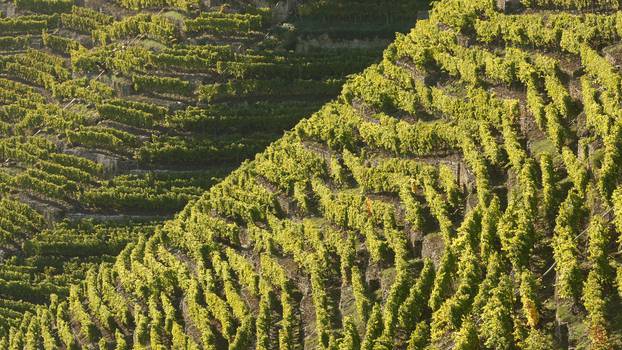
Shell limestone (Muschelkalk)
About 243-235 million years ago shell limestone sediments were deposited in the shallow sea basins and consequently transformed into limy, fossil rich stone. This soil stores heat very well and has the capacity to release it very slowly. Its typically high clay content faciliates the storage of water.


Bönnigheimer
Our Bönnigheimer Ortsweine are produced on our best sites vineyards in the area, that are planted with traditional varieties best suited to the particular site . With intensive manual labour and a rigorous yield reduction outstanding wines are produced that reflect beautifully their origin. Therefore in addition, they bear the soil formation on the label.
Variety: Lemberger, Pinot Noir, Pinot Blanc, Riesling
Soil: Schilfsandstein, Gipskeuper, weathered limestone

Schilfsandstein ("Reed sandstone", the name derives from abundant horsetail fossils)
The Schilfsandstein is characterised by its fine granulation and its high minerality. It was formed about 225 million years ago, when sandy river banks were slowly transformed into massive sandstone formations. The name originates from fossil plants found within the stones that were wrongly assumed to be reed stems.
Gipskeuper
The Gipskeuper with its limy soil constitutes the first rise in the so-called Keuperlandschaft (keuper landscape). The soils are rich with clay and heavy. Carbonate dissolved from the lime dominates the soil water and slows down weathering. As a result, the 200-million-year-old soils are rather poorly developed. Throughout the centuries, wine-growers have deeply loosened up and ploughed the heavy keuper formations and thus transformed them into man-made Rigosol soil.

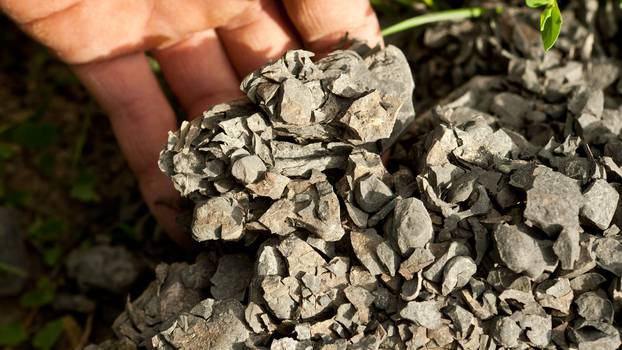
Cleebronner
Our vineyards in Cleebronn are situated on an elevated Schilfsandstein plateau. The microclimate there is ideal for the early-ripening Spätburgunder grape. We can wait for the perfect point of ripeness without worrying about high alcohol contents. Wines from this site are impressively fruity and elegant.
Variety: Spätburgunder
Soil: Schilfsandstein, rocky sand and clay
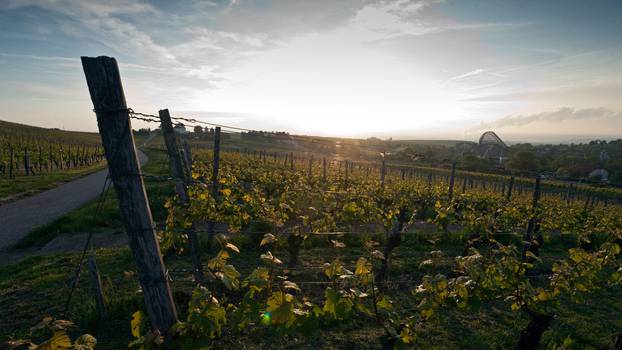
Schilfsandstein ("reed sandstone", the name derives from abundant horsetail fossils)
The Schilfsandstein is characterised by its fine granulation and its high minerality. It was formed about 225 million years ago, when sandy river banks were slowly transformed into massive sandstone formations. The name originates from fossil plants found within the stones that were wrongly assumed to be reed stems.

